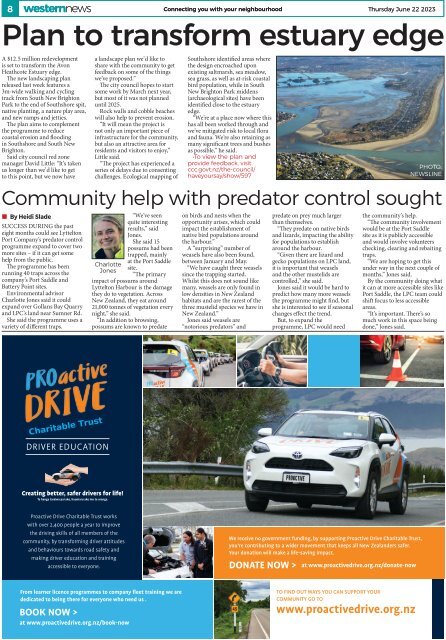Western News: June 22, 2023
Create successful ePaper yourself
Turn your PDF publications into a flip-book with our unique Google optimized e-Paper software.
8<br />
Thursday <strong>June</strong> <strong>22</strong> <strong>2023</strong><br />
Plan to transform estuary edge<br />
A $12.5 million redevelopment<br />
is set to transform the Avon<br />
Heathcote Estuary edge.<br />
The new landscaping plan<br />
released last week features a<br />
3m-wide walking and cycling<br />
track from South New Brighton<br />
Park to the end of Southshore spit,<br />
native planting, a nature play area,<br />
and new ramps and jetties.<br />
The plan aims to complement<br />
the programme to reduce<br />
coastal erosion and flooding<br />
in Southshore and South New<br />
Brighton.<br />
Said city council red zone<br />
manager David Little: “It’s taken<br />
us longer than we’d like to get<br />
to this point, but we now have<br />
• By Heidi Slade<br />
SUCCESS DURING the past<br />
eight months could see Lyttelton<br />
Port Company’s predator control<br />
programme expand to cover two<br />
more sites – if it can get some<br />
help from the public.<br />
The programme has been<br />
running 40 traps across the<br />
company’s Port Saddle and<br />
Battery Point sites.<br />
Environmental advisor<br />
Charlotte Jones said it could<br />
expand over Gollans Bay Quarry<br />
and LPC’s land near Sumner Rd.<br />
She said the programme uses a<br />
variety of different traps.<br />
a landscape plan we’d like to<br />
share with the community to get<br />
feedback on some of the things<br />
we’ve proposed.”<br />
The city council hopes to start<br />
some work by March next year,<br />
but most of it was not planned<br />
until 2025.<br />
Rock walls and cobble beaches<br />
will also help to prevent erosion.<br />
“It will mean the project is<br />
not only an important piece of<br />
infrastructure for the community,<br />
but also an attractive area for<br />
residents and visitors to enjoy,”<br />
Little said.<br />
“The project has experienced a<br />
series of delays due to consenting<br />
challenges. Ecological mapping of<br />
Community help with predator control sought<br />
Charlotte<br />
Jones<br />
“We’ve seen<br />
quite interesting<br />
results,” said<br />
Jones.<br />
She said 15<br />
possums had been<br />
trapped, mainly<br />
at the Port Saddle<br />
site.<br />
“The primary<br />
impact of possums around<br />
Lyttelton Harbour is the damage<br />
they do to vegetation. Across<br />
New Zealand, they eat around<br />
21,000 tonnes of vegetation every<br />
night,” she said.<br />
“In addition to browsing,<br />
possums are known to predate<br />
Southshore identified areas where<br />
the design encroached upon<br />
existing saltmarsh, sea meadow,<br />
sea grass, as well as at-risk coastal<br />
bird population, while in South<br />
New Brighton Park middens<br />
(archaeological sites) have been<br />
identified close to the estuary<br />
edge.<br />
“We’re at a place now where this<br />
has all been worked through and<br />
we’ve mitigated risk to local flora<br />
and fauna. We’re also retaining as<br />
many significant trees and bushes<br />
as possible,” he said.<br />
•To view the plan and<br />
provide feedback, visit<br />
ccc.govt.nz/the-council/<br />
haveyoursay/show/597<br />
on birds and nests when the<br />
opportunity arises, which could<br />
impact the establishment of<br />
native bird populations around<br />
the harbour.”<br />
A “surprising” number of<br />
weasels have also been found,<br />
between January and May.<br />
“We have caught three weasels<br />
since the trapping started.<br />
Whilst this does not sound like<br />
many, weasels are only found in<br />
low densities in New Zealand<br />
habitats and are the rarest of the<br />
three mustelid species we have in<br />
New Zealand.”<br />
Jones said weasels are<br />
“notorious predators” and<br />
predate on prey much larger<br />
than themselves.<br />
“They predate on native birds<br />
and lizards, impacting the ability<br />
for populations to establish<br />
around the harbour.<br />
“Given there are lizard and<br />
gecko populations on LPC land,<br />
it is important that weasels<br />
and the other mustelids are<br />
controlled,” she said.<br />
Jones said it would be hard to<br />
predict how many more weasels<br />
the programme might find, but<br />
she is interested to see if seasonal<br />
changes effect the trend.<br />
But, to expand the<br />
programme, LPC would need<br />
PHOTO:<br />
NEWSLINE<br />
the community’s help.<br />
“The community involvement<br />
would be at the Port Saddle<br />
site as it is publicly accessible<br />
and would involve volunteers<br />
checking, clearing and rebaiting<br />
traps.<br />
“We are hoping to get this<br />
under way in the next couple of<br />
months,” Jones said.<br />
By the community doing what<br />
it can at more accessible sites like<br />
Port Saddle, the LPC team could<br />
shift focus to less accessible<br />
areas.<br />
“It’s important. There’s so<br />
much work in this space being<br />
done,” Jones said.<br />
Charitable Trust<br />
DRIVER EDUCATION


















